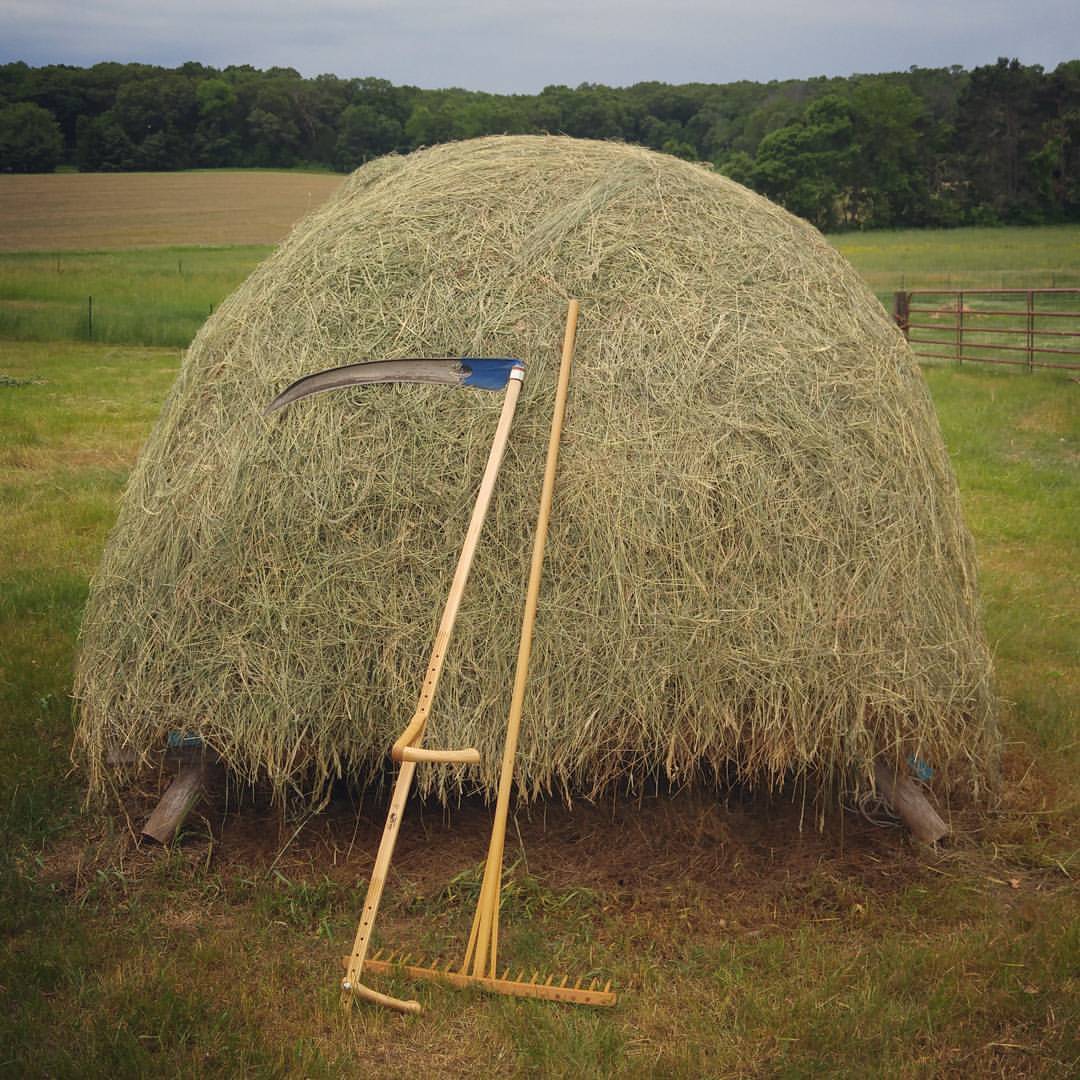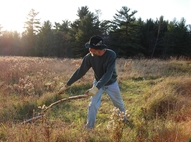|
It's been a while since I have posted an update on my experiments with my pyramid haystack system. I've been working with beefing up the haystack frame with cedar posts, and covering the stack with used billboard tarps. To follow the whole thread, you can start at the first haystack blog post. For this update I posted three new videos on YouTube showing how I build up my pyramid haystacks. I also have the videos posted at the bottom of this blog entry. Over the years I have often been asked how I get the shape of the stack to come out so well. It seems to be something people are having trouble with. Like many of my previous scythe videos, I don't shy away from showing how the work gets done in real time, so I don't speed up the footage. My intent is to give a realistic sense of the time and amount of work involved. But don't worry, my Siamese cat does his best to keep you entertained!
2 Comments
When I tell people about my scythes, they often comment that "Yes, scythes are a useful tool, but you can't mow a whole field with one." Well they used to; and in some parts of the world, they still do! It's a matter of scale, number of scythers, and time. Here's a series of 4 videos on YouTube, from Serbia, posted by misicgricko5, where they are mowing a rather large field as a group. I am often told, "but you can't mow a whole field with a scythe." Well, people used to, and still do in some parts of the world. I'm the only scyther here on my farm, so I just mow small sections at a time. But I am always amazed at how much grass gets cut in a day, when I teach a scythe workshop, with 6-12 mowers. When they all go home at the end of a workshop, and I have to tedd and process all the hay that they cut, all by myself, it can be quite overwhelming. Here is a lovely little documentary showing how large fields can be mowed by hand. In The Scythe Book, Tresamer talks about the tremendous diversity of plants that old-time pastures and hay fields used to have, and he also briefly mentions how farmers used to make special herbal hay with their scythes, for the health of their animals, and ultimately themselves. Here in this video below, a mountain farmer from Murau, Austria, explains the optimal stage at which to cut an herbal meadow, for the first cutting of hay, for maximum herbal strength and mineral content. She also talks about the healing properties of some of the herbs, and how much her cows enjoy and benefit from them. Modern fields have much less diversity, which is why she heads up high into the mountain to cut the old hayfields that mechanised farming hadn't adulterated. As for timing the first cut, conventional wisdom now is that the best time to mow for hay, is before the grass has started to head out, because it has the most protein at this stage. But from what I've read in old German scythe literature, the traditional time to mow the first cutting was "when the meadow is in bloom", as Maria Berger (Women's World Scythe Champion in 2000) is explaining in the video. Usually around St. John's Day, which is close to the summer solstice. Also happens to coincide with the longest day length of the year, for the quickest drying time of this massive volume of hay. To everything there is a season. I am often asked this question. Watch the video below, and decide for yourself. It was posted on YouTube by Handmaelcher. It shows alpine hay making in Engelberg, Switzerland. In 2006 I attended the International Scythe Symposium, hosted by the Vido family on their farm in New Brunswick, Canada. The event was a delight for a photographer. I took a lot of pictures. I had posted some of them in the photo gallery on my farm website before, but in an awkward format. Since it's still winter here, and there's not a whole lot of mowing going on, I thought I'd revisit the Symposium with this blog, and re-post the pictures with the great multimedia features of this Wordpress blog. The slide show above is of the mowing workshops at the Symposium. Hope you enjoy it. Please comment and feel free to ask questions. I will add more text and photos over time.
Here is a vintage gem, filmed prior to 1950, showing how they mowed and made hay with a scythe in Mittelberg, Austria. It was posted on YouTube by feworieser. (If the music is too overwhelming you can click the volume button and mute it, and watch it as the silent film it was probably made to be.)
It shows what the traditional mowing with an Austrian scythe was like, before mowing with a side-shift. It also shows peening with a tall anvil, honing (Austrian style), and some very impressive technique with spreading the cut vegetation with a hayfork at 2:12. It also shows how they brought the hay to the barn with a garden cart, and bundling the hay with rope for carrying on the back from areas to steep for a cart. Most interestingly to me, at 3:34 and at 5:00, it shows how the traditional Austrian hay drying racks are used. |
Botan AndersonArchives
March 2023
Categories
All
|


 RSS Feed
RSS Feed